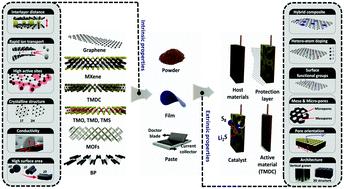当前位置:
X-MOL 学术
›
Energy Environ. Sci.
›
论文详情
Our official English website, www.x-mol.net, welcomes your
feedback! (Note: you will need to create a separate account there.)
Rational design of two-dimensional nanomaterials for lithium–sulfur batteries
Energy & Environmental Science ( IF 32.4 ) Pub Date : 2019-11-19 , DOI: 10.1039/c9ee02049g Milan Jana 1, 2, 3, 4 , Rui Xu 5, 6, 7, 8, 9 , Xin-Bing Cheng 8, 10, 11, 12, 13 , Jeong Seok Yeon 1, 2, 3, 4 , Jae Min Park 1, 2, 3, 4 , Jia-Qi Huang 6, 7, 8, 9 , Qiang Zhang 8, 10, 11, 12, 13 , Ho Seok Park 1, 2, 3, 4, 14
Energy & Environmental Science ( IF 32.4 ) Pub Date : 2019-11-19 , DOI: 10.1039/c9ee02049g Milan Jana 1, 2, 3, 4 , Rui Xu 5, 6, 7, 8, 9 , Xin-Bing Cheng 8, 10, 11, 12, 13 , Jeong Seok Yeon 1, 2, 3, 4 , Jae Min Park 1, 2, 3, 4 , Jia-Qi Huang 6, 7, 8, 9 , Qiang Zhang 8, 10, 11, 12, 13 , Ho Seok Park 1, 2, 3, 4, 14
Affiliation

|
The inherent technical challenges of lithium–sulfur (Li–S) batteries have arisen from the intrinsic redox electrochemistry occurring on the Li and S electrodes, which can significantly deteriorate the S utilization and life cycle. Two-dimensional (2D) nanomaterials composed of atomic or near-atomic thickness with infinite lateral dimensions have been proven to be meritorious as emerging materials for energy storage applications due to their unique structures, remarkable physical properties, and tunable surface chemistry. Herein, we argue that surface functionalization or heteroatom doping of 2D materials, hybridization with other nanostructured materials (0D quantum dots, 1D nanotubes/nanowires, and other 2D nanosheets), and finally architecting into 3D structures along with the advantages of 2D building blocks can open up new opportunities for Li–S batteries. We also focus on the future directions of Li–S batteries in the design of S cathodes and separators utilizing the intrinsic and extrinsic properties of 2D nanomaterials.
中文翻译:

锂硫电池二维纳米材料的合理设计
锂硫电池(Li–S)固有的技术挑战来自Li和S电极上发生的固有氧化还原电化学反应,这可能会严重降低S的利用率和使用寿命。由原子或接近原子的厚度组成且具有无限横向尺寸的二维(2D)纳米材料由于其独特的结构,卓越的物理性能和可调的表面化学性质,被证明是新兴的能量存储应用材料,值得称赞。在本文中,我们认为2D材料的表面功能化或杂原子掺杂,与其他纳米结构材料(0D量子点,1D纳米管/纳米线和其他2D纳米片)的杂交,最后,将建筑设计成3D结构以及2D构建块的优势可以为Li-S电池开辟新的机遇。在利用2D纳米材料的本征和非本征特性设计S阴极和隔板时,我们还将重点放在Li-S电池的未来发展方向上。
更新日期:2019-11-19
中文翻译:

锂硫电池二维纳米材料的合理设计
锂硫电池(Li–S)固有的技术挑战来自Li和S电极上发生的固有氧化还原电化学反应,这可能会严重降低S的利用率和使用寿命。由原子或接近原子的厚度组成且具有无限横向尺寸的二维(2D)纳米材料由于其独特的结构,卓越的物理性能和可调的表面化学性质,被证明是新兴的能量存储应用材料,值得称赞。在本文中,我们认为2D材料的表面功能化或杂原子掺杂,与其他纳米结构材料(0D量子点,1D纳米管/纳米线和其他2D纳米片)的杂交,最后,将建筑设计成3D结构以及2D构建块的优势可以为Li-S电池开辟新的机遇。在利用2D纳米材料的本征和非本征特性设计S阴极和隔板时,我们还将重点放在Li-S电池的未来发展方向上。











































 京公网安备 11010802027423号
京公网安备 11010802027423号